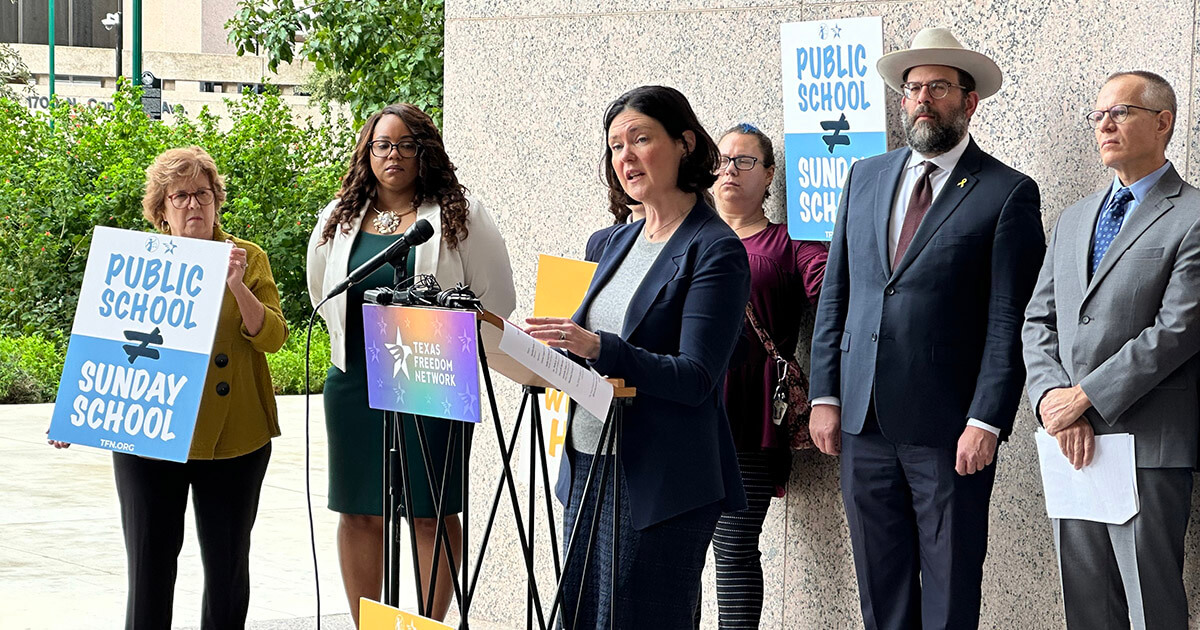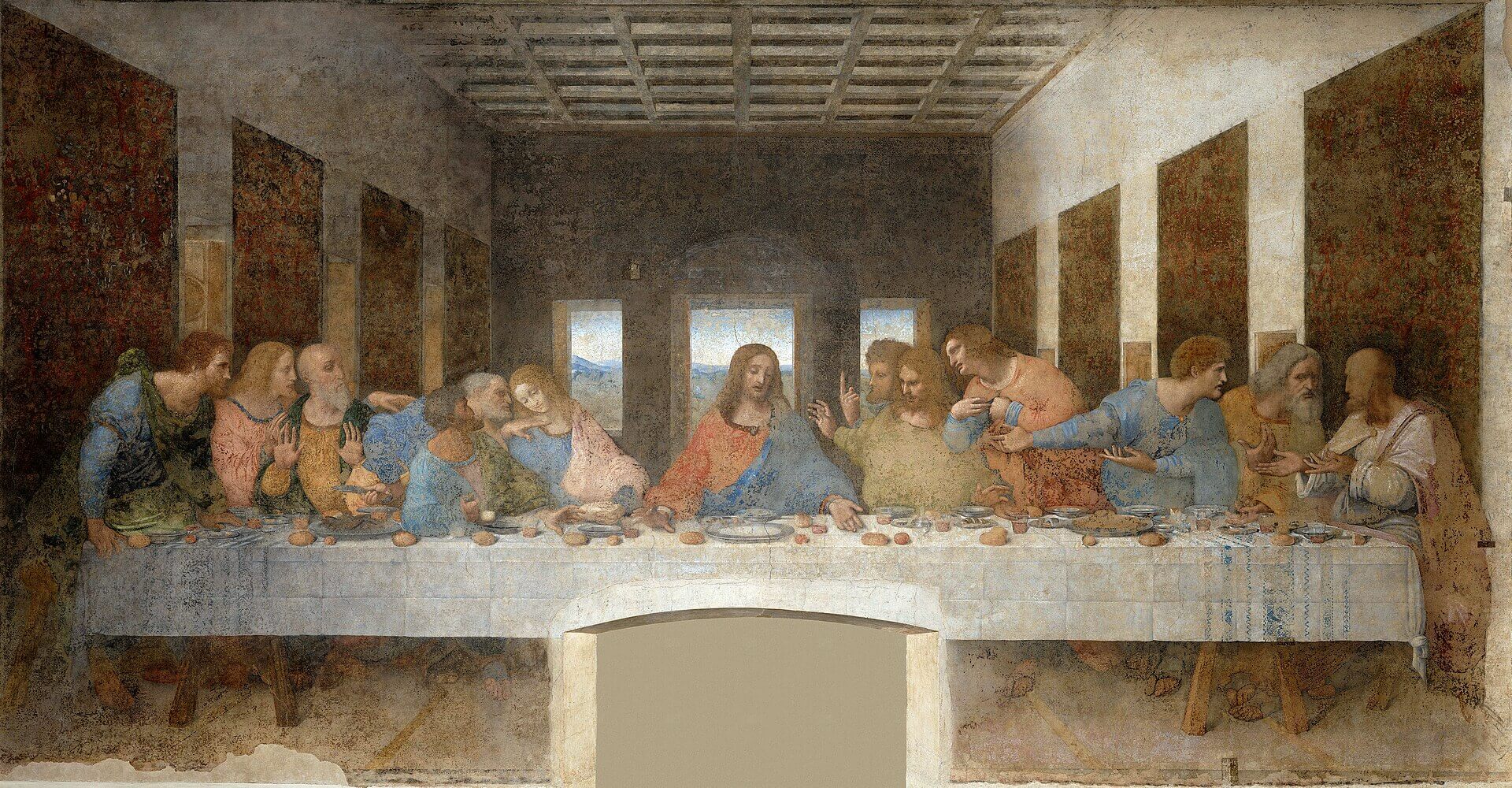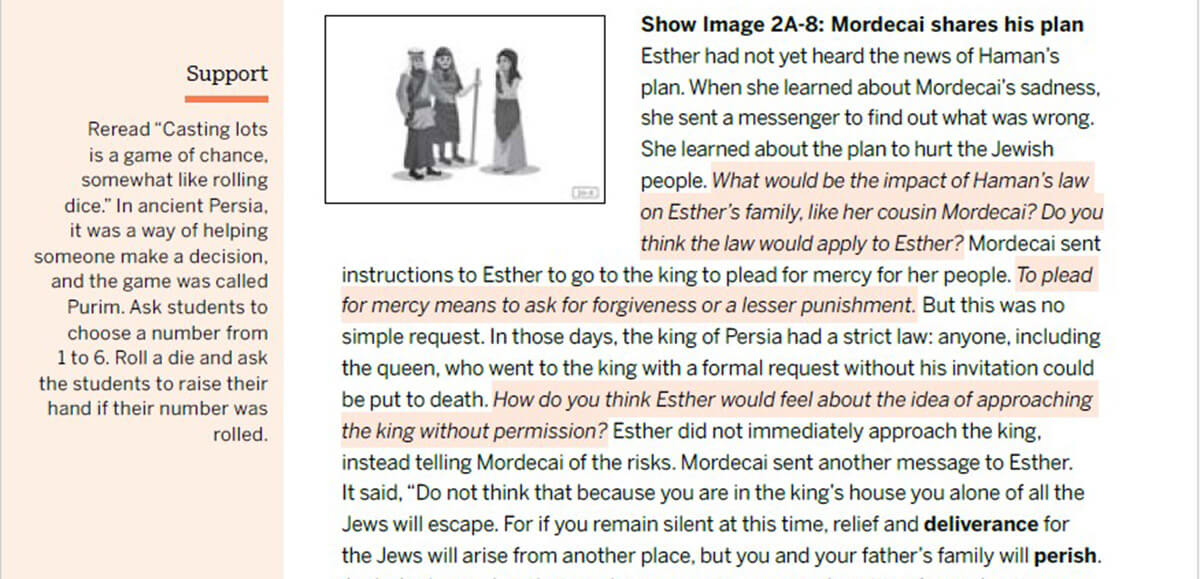Texas schools want to add Queen Esther to the curriculum. Here’s why Jews (and many Christians) are opposed.
The Texas Board of Education plans to vote on Bluebonnet Learning this week

Amanda Tyler of the Baptist Joint Committee for Religious Liberty speaks at a press conference outside a hearing of the Texas State Board of Education on adopting a Bible-infused curriculum for public schools. Rabbi Neil Blumofe is in the back, wearing a hat. Courtesy of Texas Freedom Network
Editor’s Note: The Texas State Board of Education voted 8-7 on Friday to approve the controversial “Bluebonnet” curriculum, which offers public schools Bible-infused lessons.
Rabbi Neil Blumofe, dressed in a dark suit and white cowboy hat, was standing near dozens of worshippers — one shouting “In Jesus’ name!,” another carrying a Christian flag, someone else blowing a shofar — in a scene that could easily have been confused for a Pentacostal tent revival.
But it was actually a gathering in the lobby of a Texas state office building in downtown Austin ahead of a vote by the state board of education. Blumofe was not surprised by the scene. “It’s not my first rodeo,” said the rabbi of Congregation Agudas Achim, a Conservative synagogue with 700 families.
The clash of religion and pedagogy took center stage this week as Texas decides whether or not to incorporate a controversial curriculum that would offer public schools Bible-infused lessons, with a strong emphasis on Christianity — and a strange fascination with Queen Esther.
What’s in the Bluebonnet curriculum?
The curriculum, known as Bluebonnet Learning and developed by the Texas Education Agency, first made headlines in the spring, when it was introduced for public feedback. It immediately drew criticism for prioritizing Christianity at the expense of other religions, including inaccurate Jewish content and devoting little attention to Islam. (A brief mention of the Prophet Muhammad was added to a revised draft.)
The U.S. Supreme Court has ruled that teaching the Bible in public schools is allowed, as long as it doesn’t cross into mandatory religious activity, which would be a violation of the First Amendment. Texas’ Bluebonnet curriculum uses Bible stories not to teach about religion, though, but for lessons in art appreciation, math, poetry and other subjects. For example, a fifth grade unit on the Renaissance teaches about Jesus and his disciples as part of instruction on Leonardo da Vinci’s The Last Supper.

“The authors appear to go out of their way to work detailed Bible lessons into the curriculum even when they are both unnecessary and unwarranted,” said David Brockman, a religious studies scholar who reviewed the curriculum. “They look like excuses for the student to do Bible study.”
In a unit teaching kindergartners how to place events in chronological order, Bluebonnet uses the story of God establishing the world in six days — creating light on the first day and humans on the last — as a sequencing task.
“This is a lot of weaving in of Christianity where it doesn’t really belong,” said Sharyn Vane, a Jewish parent of two Texas public school graduates who spoke at a September hearing against the curriculum. This mixing of faith and fact is likely to confuse the “youngest, most impressionable learners,” she said. “They’re not going to be able to make that distinction. They’ll say, ‘This is how the world was created. This is what we talked about in school.’”
The fascination with Queen Esther
The proposed second grade Bluebonnet curriculum has a unit called “Fighting for a Cause.” There are 14 sections; two of them focus on Queen Esther. The others are about historical figures, including Jackie Robinson, Martin Luther King Jr., Rosa Parks, Cesar Chavez and William Penn.
The Esther sections are used to teach, among other things, reading comprehension — “fasted” means someone “did not eat for a period of time, sometimes for religious reasons” — and writing, including asking the students to compose a free verse poem about the Jewish queen.
In a section teaching the meaning of the words “perish” and “plot,” students are told about Haman who, in the Old Testament, used a lottery system to determine what date to murder all of Persia’s Jews. In the original draft of this lesson, students were told to roll a dice to see if their number was chosen. “It just feels really problematic that you would have elementary schoolers reenacting this,” Vane said. “You wouldn’t have people do a slave auction, or have kindergartners pretend to be Hitler.”

Another section told the story of how Mordechai could not bow down to Haman because it was prohibited by Jewish law. “This is demonstrably false,” said Mark Chancey, a professor of religious studies at Southern Methodist University in Dallas, who found several errors in the curriculum. “You basically had this lesson making up a new commandment in the Torah.”
After complaints from Chancey, Jewish parents and others, the dice-rolling game and the made-up mitzvah were ultimately removed from the final version of the curriculum being voted on this week. In the section on historical figures, the word “historical” was removed. But other Esther references remain, often with glaring mischaracterizations.
One unit frames the Esther narrative — which took place centuries before Jesus — as a heroine fighting so her people are “free to practice their religion without being harmed by her country’s government.” In this telling, Haman targets the Jews because of a xenophobic aversion to different customs. “What is at stake in the Book [of Esther] is Jewish survival,” Chancey said, “not freedom of religious practice.”
Bluebonnet also refers to Esther’s faith in God. But, Chancey pointed out, “the Book of Esther famously does not even include the word God,” adding that “they are just adding content, adapting the lesson for a particular political agenda and imposing particular religious interpretations on this lesson.”
While Christian appropriation of Queen Esther’s story is not new — VeggieTales, the Christian cartoon series, aired an Esther episode back in 2000 — there is a renewed focus on the heroine. “This comes at a time when, in some evangelical circles, Esther is being appropriated for particular ideological ends,” said Chancey.
During this year’s presidential election, Christian activists invoked the story of Esther, most notably at a D.C. rally called “A Million Women: an Esther Call to the Mall,” which drew tens of thousands. Inspired by Esther’s courage to speak up, they were calling on modern-day Esthers to stand up against issues like abortion and transgender rights.
Alarmed by abortion and transgender rights, Christian activists are invoking the Old Testament story of Esther, the Jewish queen who bravely saved her people.https://t.co/AlRWydUg3k
— Benyamin Cohen (@benyamincohen) November 20, 2024
The group behind Project 2025, the controversial blueprint for a second Trump administration, released a plan to counter antisemitism that’s called Project Esther. The Heritage Foundation, the conservative think tank behind the plan, said it worked with 57 Jewish organizations on the 33-page document, but several of the groups listed said they played no part in the process. It was instead drafted by a coalition made up largely of evangelical Christian groups.
The Lord in the Lone Star State
The authors of the Bluebonnet curriculum, like the Bible itself, are somewhat shrouded in secrecy. The work was contracted as part of a pandemic-era order, with usual state requirements for transparency waived.
The 74, a nonprofit news outlet covering education issues, reported Monday that Texas outsourced the work to many companies — including Espired, a conservative publishing house co-founded by former Arkansas Gov. Mike Huckabee. Last week, President-elect Donald Trump tapped Huckabee, a Southern Baptist minister and evangelical hardliner, to be the U.S. ambassador to Israel.
The Texas State Board of Education is expected to make a final decision about the curriculum on Friday. If approved, schools would not be required to use the Bluebonnet curriculum; Texas’ 1,207 school districts would each decide whether to adopt it. However, the state will be offering financial incentives to the districts that implement Bluebonnet: $60 per student.
“The problem is Texas is underfunding our schools,” said Courtney Toretto, who works for the Anti-Defamation League and whose five-year-old daughter, Charley, is a student in the Austin public school system. “This is a big incentive for schools that are already cash strapped.”
The Bible-infused Bluebonnet curriculum is just the latest step Texas is taking to bring religion into taxpayer-funded schools. A 2021 law requires public schools to display all “In God We Trust” posters that are donated to them. A 2023 law allows unlicensed religious chaplains to offer mental health counseling at public schools. Lt. Gov. Dan Patrick has vowed to push for legislation in 2025 that would require the Ten Commandments to be displayed in every public school classroom in Texas, following a similar requirement in Louisiana, which has been blocked by a federal judge.
“The context of what this curriculum comes into is not a vacuum,” said Vane. “We see a lot of efforts to elevate Christianity and blur that line in the separation between church and state.”

More empathy, less favoritism
Chancey, a United Methodist, said he got into the field of religion and education because he was concerned about the experiences that Jewish children were having in public schools. “If the public school can play religious favorites,” he said, “then my tradition might benefit this week and be demonized next week.”
Many ministers testified against Bluebonnet in front of the board of education in September and again this week. “Christians differ theologically among themselves,” said Chancey, who also works with Christians Against Christian Nationalism. “The schools might not teach the Bible stories the way that parents would like.”
Rabbi Blumofe emphasized the importance of empathy in remarks he gave Monday on the steps of the state office building, forced to relocate from the lobby because of the group praying inside. “Let us teach citizenship, compassion, confidence, and inquiry in our classrooms,” he said. “And yet, let us neither sleepwalk nor strut in this time of great confusion and divisiveness in our world. We can do well by our students — teaching a narrow view of God’s word is not the answer.”
Blumofe added that “even if this does pass, I don’t think it’s a death knell for positive and important relationships. It’s a matter of pouring yourself into other people’s communities and inviting them into yours. I don’t think it’s an us-and-them proposition at all.”
‘It left scars’
If the board votes on Friday to approve Bluebonnet, it will likely face legal challenges from concerned parents and civil liberties groups. “I’m a religion scholar, not a constitutional scholar,” said Brockman, “but I expect that it will be the target of lawsuits.”
Brockman, who is Episcopalian, was invited to speak about the curriculum at a Dallas synagogue, where he described being bullied growing up. “It left scars,” he said. “I think that what we’re seeing here is actually a minority group of Christians attempting to force their religious perspective and using the levers of power to essentially lord it over all the rest of us, those of us who are not evangelical Christians, and those who are not Christian and not religious either. For me, this is just another form of bullying.”
Toretto of the ADL also testified in front of the school board this week. “We put together a team and combed through the curriculum,” said Toretto. “We’ve been training parents, grandparents and potential future parents [on] the difference between teaching about religion and teaching religion.”
She added: “This does a real disservice to Texas school kids. They deserve a strong, unbiased taxpayer-funded education system, and that is not what they’re getting with this curriculum.”
Toretto grew up in Orange County, California, and attended a school where she was one of the few Jewish students. “I was told I was not going to heaven,” she recalled. “I was told I was going to be left behind. And right now, my child is very proud of being Jewish, and a curriculum like this can take that away from her and make her feel that she’s so different, that she doesn’t fit in.”
















